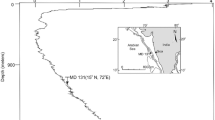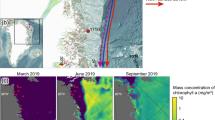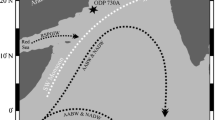Abstract
Benthic foraminiferal turnover during the Palaeocene–Eocene Thermal Maximum (PETM) has been extensively studied but numerous questions remained unresolved, question such as why some foraminiferal species went into extinction at a particular location but survive in another or why some species survive in extremely low oxygen environment. Because foraminiferal community interaction with the environment is driven by biological traits instead of taxonomic composition, this study has adopted trait-based approach to provide insight into the life strategies of foraminifera that enables them to survive in extreme environmental conditions. The result from this study shows that traits such as test composition, perforation, ornamentation and living habits play an important role in the ecological functioning and adaptability of foraminifera in the environment. The faunal assemblage in the studied site is dominantly cosmopolitan taxa suggesting the environment was perturbed during the PETM. Foraminiferal composition is characterised by faunal turnover indicated in extensive mortalities and extinction of both planktonic and benthic fauna. The ordination (non-metric dimensional scaling) of faunal composition also indicated ecological disturbance. The planktonic community was relatively stable before and after PETM but experienced a high level of ecological perturbation during the carbon isotopic excursion (CIE). The benthic community showed higher evidence of perturbation as the fauna assemblage ordination indicated that ecological stress started before the PETM with the disarray of samples in the ordination diagram. Only the recovery interval experienced some level of ecological stability. The environmental disturbance noticed in the fauna composition reflected on the trait. Benthic foraminiferal traits indicated instability throughout the studied section. The evidence of environmental disturbance in the benthic community suggests that the source of the light carbon that caused the PETM may have originated beneath sea floor in the Atlantic Ocean.









Similar content being viewed by others
Notes
Biological trait analysis (BTA) is a procedure that allows the traits of organisms to be quantified was used to examine the foraminiferal trait changes/variability across the analysed section.
References
Alegret L, Thomas E (2009) Food supply to the seafloor in the Pacific Ocean after the Cretaceous/Paleogene boundary event. Mar Micropaleontol 73(1–2):105–116
Alegret L, Ortiz S, Molina E (2009) Extinction and recovery of benthic foraminifera across the Paleocene- Eocene Thermal Maximum at the Alamedilla section (Southern Spain). Palaeogeogr Palaeoclimatol Palaeoecol 279:186–200
Armstrong HA, Brasier MD (2005) Microfossils, 2nd edn. Blackwell Publishing, Oxford, p 304
Arreguín-Rodríguez GJ, Alegret L, Thomas E (2016) Late Paleocene-middle Eocene benthic foraminifera on a Pacific seamount (Allison Guyot, ODP Site 865): Greenhouse climate and superimposed hyperthermal events. Paleoceanography 31:346–364
Aze T, Pearson PN, Dickson AJ, Badger MPS, Bown PR, Pancost RD, Gibbs SJ, Huber BT, Leng MJ, Coe AL, Cohen AS, Foster GL (2014) Extreme warming of tropical waters during the Paleocene-Eocene Thermal Maximum. Geology 42:739–742
Babila TL, Penman DE, Hönisch B, Kelly DC, Bralower TJ, Rosenthal Y, Zachos JC (2018) Capturing the global signature of surface ocean acidification during the Palaeocene-Eocene Thermal Maximum. Phil Trans R Soc A 376(20170072):1–19. https://doi.org/10.1098/rsta.2017.0072
Boltovskoy E, Scott DB, Medioli FS (1991) Morphological variations of benthic foraminiferal tests in response to changes in ecological parameters: a review. J Paleontol 65:175–185
Boscolo Galazzo F, Thomas E, Pagani M, Warren C, Luciani V, Giusberti L (2014) The middle Eocene climatic optimum (MECO): a multiproxy record of paleoceanographic changes in the southeast Atlantic (ODP Site 1263, Walvis Ridge). Paleoceanography 29:1143–1161
Boscolo Galazzo F, Thomas E, Giusberti L (2015) Benthic foraminiferal response to the Middle Eocene Climatic Optimum (MECO) in the Southeastern Atlantic (ODP Site 1263). Palaeogeogr Palaeocl Palaeoecol 417:432–444
Bremner J, Rogers SI, Frid CLJ (2006) Methods for describing ecological functioning of marine benthic assemblages using biological traits analysis (BTA). Ecol Indic 6(3):609–622
Buzas MA, Culver SJ, Jorissen FJ (1993) A statistical evaluation of the microhabitats of living (stained) infaunal benthic foraminifera. Mar Micropaleont 29:73–76
Caswell BA, Frid CLJ (2013) Learning from the past: functional ecology of marine benthos during eight million years of aperiodic hypoxia, lessons from the Late Jurassic. Oikos 122(12):1687–1699
Caswell BA, Frid CL (2017) Marine ecosystem resilience during extreme deoxygenation: the Early Jurassic oceanic anoxic event. Oecologia 183(1):275–290. https://doi.org/10.1007/s00442-016-3747-6
Charvet S, Kosmala A, Statzner B (1998) Biomonitoring through biological traits of benthic macroinvertebrates: perspectives for a general tool in stream management. Arch Hydrobiol 142:415–432
Chevenet F, Dolédec S, Chessel D (1994) A fuzzy coding approach for the analysis of long-term ecological data. Freshw Biol 31:295–309
Clarke KR, Gorley R N (2006) Primer v6 Plymouth Marine Laboratory, Roborough, Plymouth, UK (2006) <www.primer-e.com>
Corliss BH, Chen C (1988) Morphotype patterns of Norwegian Sea deep-sea benthic foraminifera and ecological implications. Geology 16:716–719
Culver SJ, Lipps JH (2003) Predation on and by Foraminifera. In: Kelley P, Kowalewski M, Hansen T (eds) Predation in the Fossil Record. Kluwer Academic/Plenum Publishers, New York, pp 7–32
Cushman JA (1951) Palaeocene foraminifera of the Gulf Coastal region of the United States and adjacent areas. U.S. Geological Survey. Prof Pap 232:1–75
D’haenens S, Bornemann A, Stassen P, Speijer R (2012) Multiple early Eocene benthic foraminiferal assemblage and δ13C fluctuations at DSDP Site 401 (Bay of Biscay - NE Atlantic). Mar Micropaleontol 88(89):15–35
DeConto RM, Galeotti S, Pagani M, Tracy D, Schaefer K, Zhang T, Pollard D, Beerling DJ (2012) Past extreme warming events linked to massive carbon release from thawing permafrost. Nature 484(7392):87–91
Dubicka Z, Złotnik M, Borszcz T (2015) Test morphology as a function of behavioural strategies — inferences from benthic foraminifera. Mar Micropaleontol 116:38–49
Frid CLJ, Caswell BA (2015) Is long-term ecological functioning stable: the case of the marine benthos? J Sea Res 98:15–23
Frid CLJ, Caswell BA (2016) Does ecological redundancy maintain functioning of marine benthos on centennial to millennial time scales? Mar Ecol 37(2):392–410
Friedrich O, Erbacher J, Wilson PA, Moriya K, Mutterlose J (2009) Paleoenvironmental changes across the Mid Cenomanian Event in the tropical Atlantic Ocean (Demerara Rise, ODP Leg 207) inferred from benthic foraminiferal assemblages. Mar Micropaleontol 71(1–2):28–40
Friedrich O, Nishi H, Pross J, Schmiedl G, Hemleben C (2005) Millennial- to Centennial-Scale interruptions of the Oceanic Anoxic Event 1b (Early Albian, mid-Cretaceous) inferred from benthic foraminiferal repopulation events. Palaios 20(1):64–77
Giusberti L, Coccioni R, Sprovieri M, Tateo F (2009) Perturbation at the sea floor during the Paleocene-Eocene Thermal Maximum: evidence from benthic foraminifera at Contessa Road, Italy. Mar Micropaleontol 70:102–119
Giusberti LB, Galazzo F, Thomas E (2016) Variability in climate and productivity during the Paleocene-Eocene Thermal Maximum in the western Tethys (Forada section). Clim Past 12(2):213–240
Gooday AJ (1994) The biology of deep-sea foraminifera: a review of some advances and their applications in paleoceanography. Palaios 9(1994):14–31
Grigoratou M, Monteiro FM, Schmidt DN, Jamie DW, Ben A, Ridgwell A (2019) A trait-based modelling approach to planktonic foraminifera ecology. Biogeosciences 16:1469–1492
Holbourn A, Henderson AS, Macleod N (2013) Atlas of Benthic Foraminifera. Wiley-Blackwell, UK, p 642
Jorissen FJ, Fontanier C, Thomas E (2007) Paleoceanographical proxies based on deep-sea benthic foraminiferal assemblage characteristics. Proxies in Late Cenozoic Paleoceanography: Pt. 2: Biological tracers and biomarkers. Elsevier, Amsterdam, The Netherlands, pp 264–325
Kaiho K (1994) Benthic foraminiferal dissolved-oxygen index and dissolved-oxygen levels in the modern ocean. Geology 22(8):719–722
Keating-Bitonti CR, Payne JL (2017) Ecophenotypic responses of benthic foraminifera to oxygen availability along an oxygen gradient in the California Borderland. Mar Ecol 38:e12430
Kennett JP, Stott LD (1991) Abrupt deep-sea warming, palaeoceanographic changes and benthic extinctions at the end of the Palaeocene. Nature 353:225–229
Littler K, Röhl U, Westerhold T, Zachos JC (2014) A high resolution benthic stable-isotope record for the South Atlantic: implications for orbital-scale changes in Late Paleocene-Early Eocene climate and carbon cycling. Palaeogeogr Palaeocl 401:18–30
Loeblich AR, Tappan H (1987) Foraminiferal Genera and Their Classification. Van Nostrand Reinhold Co, New York, p 2031
Luciani V, Giusberti L, Agnini C, Backman J, Fornaciari E, Rio D (2007) The Paleocene-Eocene Thermal Maximum as recorded by Tethyan planktonic foraminifera in the Forada section (northern Italy). Mar Micropaleontol 64:189–214
Lyons SL, Baczynski AA, Babila TL, Bralower TJ, Hajek EA, Kump LR, Polites EG, Self-Trail JM, Trampush SM, Vornlocher JR, Zachos JC, Freeman KH (2019) Palaeocene-Eocene Thermal Maximum prolonged by fossil carbon oxidation. Nat Geosci 12:54–60
Murray JW (1991) Ecology and palaeoecology of benthic foraminifera. Longman, Harlow, p 397
Nomura R (1991) Paleoceanography of upper Maestrichtian to Eocene benthic foraminiferal assemblages at Sites 752, 753, and 754, Eastern Indian Ocean. In: Weissel J, Peirce J, Taylor E, Alt J, et al., Proc. ODP, Science party. Results, 121: College Station, TX (Ocean Drilling Program), 121:3–30
Nwojiji CN, Osterloff P, Okoro AU, Ndulue G (2014) Foraminiferal stratigraphy and paleoecological interpretation of sediments penetrated by Kolmani River -1 Well, Gongola Basin, Nigeria. J Geosci Geomat 2(3):85–93
Nwojiji CN, Fabienne M (2019) The PETM extreme climate impact on the benthic foraminiferal traits and ecological functioning in the tropical Pacific and Tethys Oceans. J Ocean Res 4(1):6–19
Nwojiji CN, Marret F, Caswell BA (2023) Planktonic foraminiferal turnover and trait changes across the Palaeocene-Eocene Thermal Maximum (PETM) at ODP site 1265A. SE Atlantic Ocean (in press), Walvis Ridge
Pak DK, Miller KG (1992) Palaeocene to Eocene benthic foraminiferal isotopes and assemblages: implications for deep water circulation. Paleoceanography 7:405–422
Pälike C, Delaney ML, Zachos JC (2014) Deep-sea redox across the Paleocene-Eocene thermal maximum. Geochem Geophys Geosyst 15(4):1038–1053. https://doi.org/10.1002/2013GC005074
Petrizzo MR (2007) The onset of the Palaeocene-Eocene Thermal Maximum (PETM) at Sites 1209 and 1210 (Shatsky Rise, Pacific Ocean) as recorded by planktonic foraminifera. Mar Micropaleontol 63(3–4):187–200
Petrizzo MR, Leoni G, Speijer RP, Bernardi BD, Felletti F (2008) Dissolution susceptibility of some Paleogene planktonic foraminifera from ODP site 1209 (Shatsky Rise, Pacific Ocean). J Foramin Res 38(4):357–371
Schiebel R, Hemleben C (2017) Planktic Foraminifers in the Modern Ocean. Springer-Verlag, Berlin Heidelberg, p 358
Schmiedl G, de Bovee F, Buscail R, Charrière B, Hemleben C, Medernach L (2000) Trophic control of benthic foraminiferal abundance and microhabitat in the bathyal Gulf of Lions, western Mediterranean Sea. Mari Micropaleontol 40(3):167–188
Speijer RP (1994) Extinction and recovery patterns in benthic foraminiferal paleocommunities across the Cretaceous/Paleogene and Paleocene/Eocene boundaries. Geol Ultraiectina 124:1–91
Stassen P, Thomas E, Speijer RP (2015) Paleocene-Eocene Thermal Maximum environmental change in the New Jersey Coastal Plain: benthic foraminiferal biotic events. Mar Micropaleontol 115:1–23
Takeda K, Kaiho K (2007) Faunal turnovers in central Pacific benthic foraminifera during the Paleocene-Eocene Thermal Maximum. Palaeogeogr Palaeoclimatol Palaeoecol 251:175–197
Thomas E (2003) Extinction and food at the seafloor: a high-resolution benthic foraminiferal record across the Initial Eocene Thermal Maximum, Southern Ocean Site 690, in: Causes and Consequences of Globally Warm Climates in the Early Paleogene, edited by: Wing SL, Gingerich PD, Schmitz B, Thomas ., Geol. S. Am. S., Boulder, Colorado, The Geological Society of America, 369: 319–332
Thomas E (2007) Cenozoic mass extinctions in the deep sea: what perturbs the largest habitat on Earth?, in: Large Ecosystem Perturbations: Causes and Consequences, edited by: Monechi S, Coccioni R, Rampino M, Geol. S. Am. S., Boulder, Colorado. Geol Soc Am 424:1–23
Thomas E, Boscolo-Galazzo F, Balestra B, Monechi S, Donner B, Röhl U (2018) Early Eocene Thermal Maximum 3: biotic response at Walvis Ridge (SE Atlantic Ocean). Paleoceanography and Paleoclimatology 33:862–883
Tjalsma RC, Lohmann GP (1983) Paleocene-Eocene Bathyal and Abyssal Benthic Foraminifera from the Atlantic Ocean. Micropaleontology. Spec Publ 4:1–90
Widmark JGV (1997) Deep-sea benthic foraminifera from Cretaceous-Tertiary boundary in the South Atlantic Ocean: taxonomy and paleoecology. Fossils Strata 43:1–94
Williams M, Haywood AM, Gregory FJ, Schmidt DN (eds) (2007). Geological Society, London, p 592
Zachos JC, Röhl U, Schellenberg SA, Sluijs A, Hodell DA, Kelly DC, Thomas E, Nicolo M, Raffi I, Lourens LJ, Mccarren H, Kroon D (2005) Rapid acidification of the ocean during the Paleocene-Eocene Thermal Maximum. Science 308:1611–1615
Zachos JC, Kroon D, Blum P (2004) Leg 208 Shipboard Scientific Party Proceeding ODP, Initial Reports, 208. College Station TX (Ocean Drilling Program), 1–112. http://www-odp.tamu.edu/publications/208_IR/208ir.htm
Zachos JC, Dickens GR, Zeebe RE (2008) An early Cenozoic perspective on greenhouse warming and carbon-cycle dynamics. Nature 451(17):279–283
Acknowledgements
This research used core samples provided by the International Ocean Discovery Program (IODP). Ebonyi State Government, Nigeria, and School of Environmental Sciences, UOL provided parts of the funding for this study.
Author information
Authors and Affiliations
Corresponding author
Ethics declarations
Conflict of interest
The authors declare no competing interests.
Additional information
Responsible Editor: Attila Ciner
Supplementary Information
Below is the link to the electronic supplementary material.
Rights and permissions
Springer Nature or its licensor (e.g. a society or other partner) holds exclusive rights to this article under a publishing agreement with the author(s) or other rightsholder(s); author self-archiving of the accepted manuscript version of this article is solely governed by the terms of such publishing agreement and applicable law.
About this article
Cite this article
Nwojiji, C., Marret, F., Caswell, B. et al. Benthic foraminiferal turnover and trait changes across the Palaeocene–Eocene Thermal Maximum (PETM) at ODP site 1265A, Walvis Ridge, SE Atlantic Ocean. Arab J Geosci 16, 324 (2023). https://doi.org/10.1007/s12517-023-11417-x
Received:
Accepted:
Published:
DOI: https://doi.org/10.1007/s12517-023-11417-x




